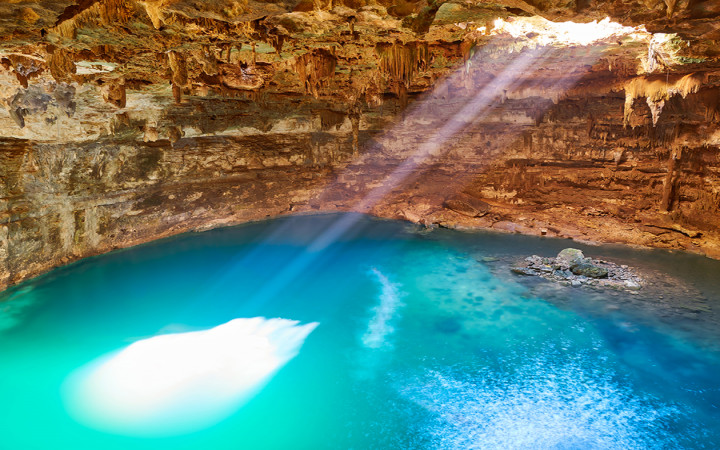Today’s Wonder of the Day was inspired by Gabriel. Gabriel Wonders, “How are under water caves made?” Thanks for WONDERing with us, Gabriel!
What do you do when the air is warm and the Sun is shining down? Many kids go swimming! Maybe you take a dip in the ocean. Perhaps you prefer a swimming pool. Either way, there’s nothing quite as refreshing as cool water on a hot summer day.
Have you ever been in Mexico’s Yucatan Peninsula during the dog days of summer? If so, you may already know about a unique geological feature that doubles as an oasis. That’s right, today we’re exploring cenotes!
What is a cenote (pronounced say-NO-tay)? It’s a natural, water-filled sinkhole. It’s made when the limestone ceiling of an underground cave collapses. Cenotes can vary in size and shape. They can be deep shafts or wide pools. Many have underwater caves and passages.
As rain and underground rivers fill the sinkhole, a pool of clear, cool, fresh water forms. This is why you’ll find thousands of cenotes in Mexico’s Yucatan Peninsula. The entire area is low and flat. It has almost no rivers or streams on its surface. Instead, a thick layer of limestone lies beneath the peninsula. It features three of the longest underground water systems in the world.
Cenotes are the peninsula’s main source of water. This is one reason why they were so important to the ancient Mayan civilization. The name “cenote” comes from the Mayan word “d’zonot.” It means “sacred well.”
The ancient Maya did consider cenotes to be sacred places. In fact, cenotes were believed to be entrances to the Mayan underworld. They believed their gods lived there. They also thought human spirits went there after death.
Today, many people visit cenotes. They love to relax in these natural swimming holes. Cenotes with underwater caves are also great places to snorkel and scuba dive. They hold amazing stalactites and stalagmites. You could even find treasure while diving in a cenote.
The Maya often used cenotes for religious, sacrificial purposes. Archeologists have found many interesting things in them. This includes the fossilized remains of ancient humans, mammoths, giant jaguars, and camels. They’ve also found items like gold, jade, and pottery.
Would you like to explore a cenote? Maybe you’ll get the chance one day! Perhaps you’ll even be one of tomorrow’s experts who study cenotes to learn about the Earth and its past. Either way, you’re sure to enjoy these beautiful natural oases!
Standards: CCRA.L.3, CCRA.L.6, CCRA.R.1, CCRA.R.2, CCRA.R.4, CCRA.R.10, CCRA.SL.1, CCRA.W.3, CCRA.L.1, CCRA.L.2




